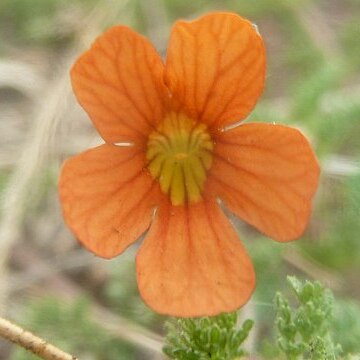Perennial herb (can flower when very young and look annual) with a woody rootstock up to c. 20 mm diam. at the crown, stems many from the crown, c. 60-300(-750) mm long, prostrate or ascending, sometimes rooting, well branched from the base and above, glandular-puberulous, hairs up to 0.1-0.25 mm long, leafy throughout. Leaves opposite at extreme base, soon alternate, pseudofasciculate, up to 5-30 x 5-16 mm, elliptic to broadly ovate in outline contracted into a petiolar part, bipinnatisect, lobes oblong or narrowly elliptic, subacute, thinly glandular-puberulous below, hairs up to 0.1-0.2 mm long, crowded glistening glands above, very rarely a few stalked hairs as well. Flowers solitary in the axils of the leaves, these upwards but nearly always dissected. Pedicels up to 7-25 mm long. Calyx tube 0.1-0.3 mm long, lobes 2.4-5 x 0.6-1(-2) mm, oblong to spathulate, usually entire, very rarely with a few teeth, glandular-pubescent, hairs up to 0.1-0.25 mm long, glistening glands as well. Corolla tube 5-7 x 1.7-2 mm, cylindric, throat slightly expanded, mouth dorsoventrally compressed, limb oblique, 6-14 mm across lateral lobes, posticous lobes 1.7-4 x 1.5-4 mm, anticous lip porrect, anticous lobe 1.7-4.5 x 1.7-5 mm, all lobes suborbicular, glandular-puberulous outside, hairs up to 0.15 mm long, glistening glands as well, broad transverse band of clavate hairs in throat extending to base of anticous lip, lobes varying in colour from bright orange to shades of red and purple-pink, throat yellow, the colour extending onto base of lower lip, the main veins coloured dark brown to purple. Stamens: posticous filaments 1-1.5 mm long, posticous anthers 0.6-1 mm, anticous filaments 0.4-0.8 mm, anticous anthers 0.4-0.7 mm, filaments minutely puberulous. Stigma 0.2-0.25 mm long, included. Style 3.2-4.5 mm long. Ovary 1.2-1.5 x 0.8-1 mm. Capsules 3.5-5 x 2-3 mm, scattered glistening glands and a few minute hairs. Seeds 0.3-0.4 x 0.3 mm. Flowering has been recorded in nearly all months of the year, but the chief season is October to March.
More
Perennial, but can look annual, many stems up to 300(-750) mm long, prostrate or ascending, much branched, glandular-puberulous, leafy. Leaves pseudofasciculate, elliptic to broadly ovate, getting smaller upwards but usually dissected, petiolate, bipinnatisect, lobes oblong or narrowly elliptic, subacute; many glistening glands on upper surface, finely glandular-hairy below. Flowers single, axillary. Calyx: tube up to 0.3 mm long; lobes oblong to spathulate, rarely with a few teeth. Corolla: tube up to 7 mm long, not much expanded upwards; limb oblique; lobes suborbicular, orange, brick-red or salmon-pink, veins dark, throat yellow.
Perennial herb. Stems many from crown, prostrate or ascending, ± 60-300(-750) mm long. Leaves with blade bipinnatisect, cut nearly to midrib, thinly glandular-puberulous below, upper surface clad in crowded glistening glands with very rarely a few glandular hairs as well. Flowers: solitary in axils of leaves; tube 5-7 mm long, corolla lobes 1.5-4.5 mm long, thin-textured, apices rounded, varying in colour from bright orange to shades of red and purple-pink, throat yellow, colour extending onto base of lower lip, main veins dark brown to purple; Oct.-Mar.
Perennial herb. Stems many from crown, 60-300(-750) mm long. Leaves bipinnatisect, cut nearly to midrib, thinly glandular-puberulous below, upper surface clad in crowded glistening glands with very rarely a few glandular hairs as well. Flowers with corolla lobes varying in colour from bright orange to shades of red and purple-pink, throat yellow, the colour extending onto base of lower lip, main veins dark brown to purple.

